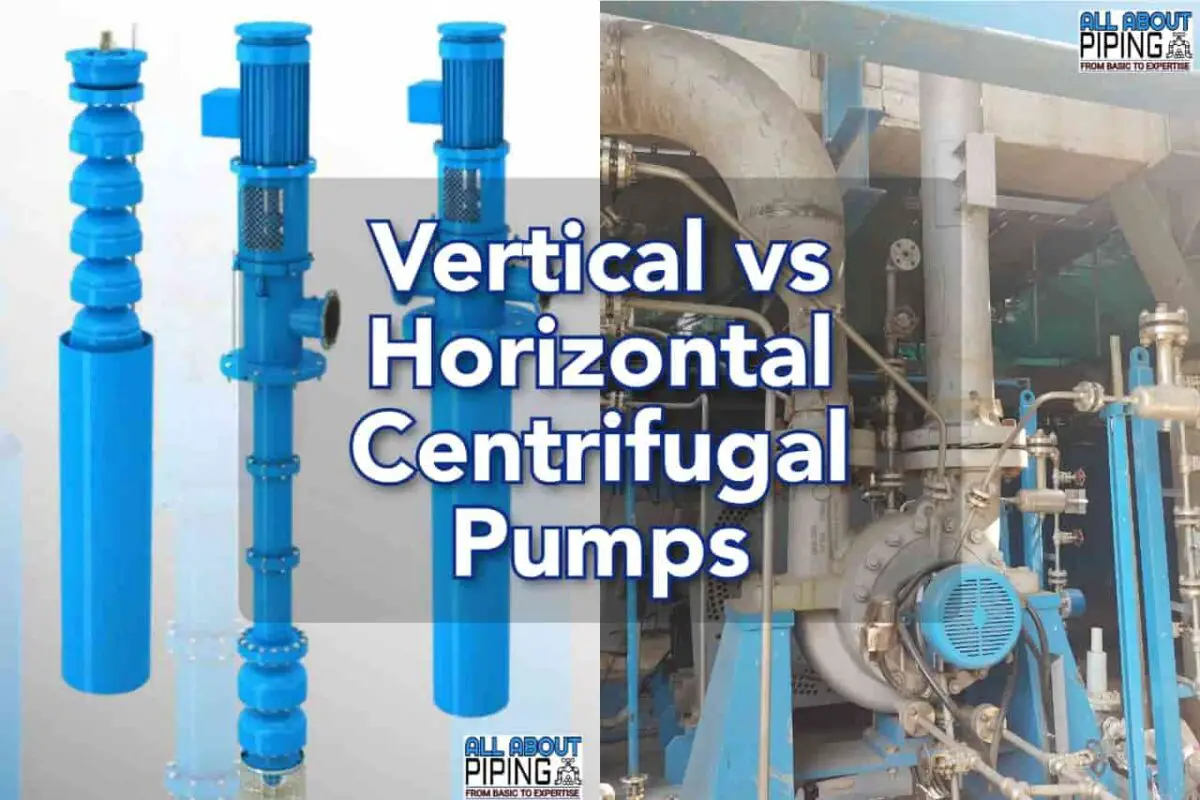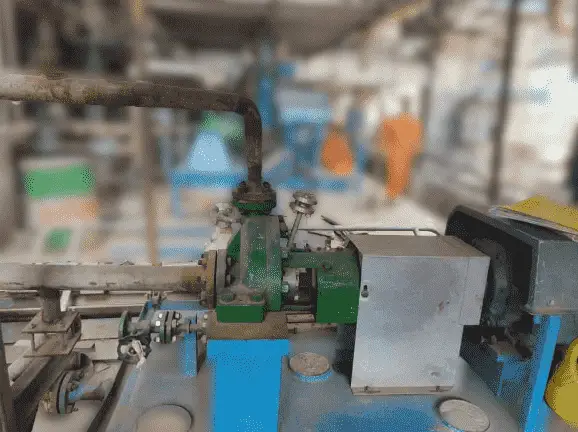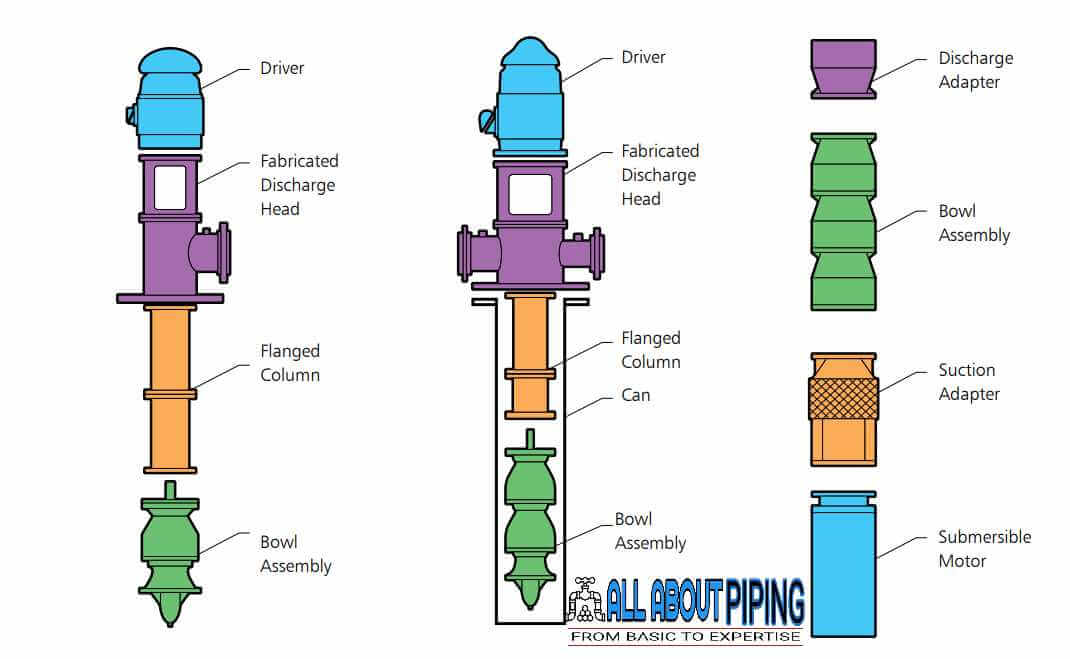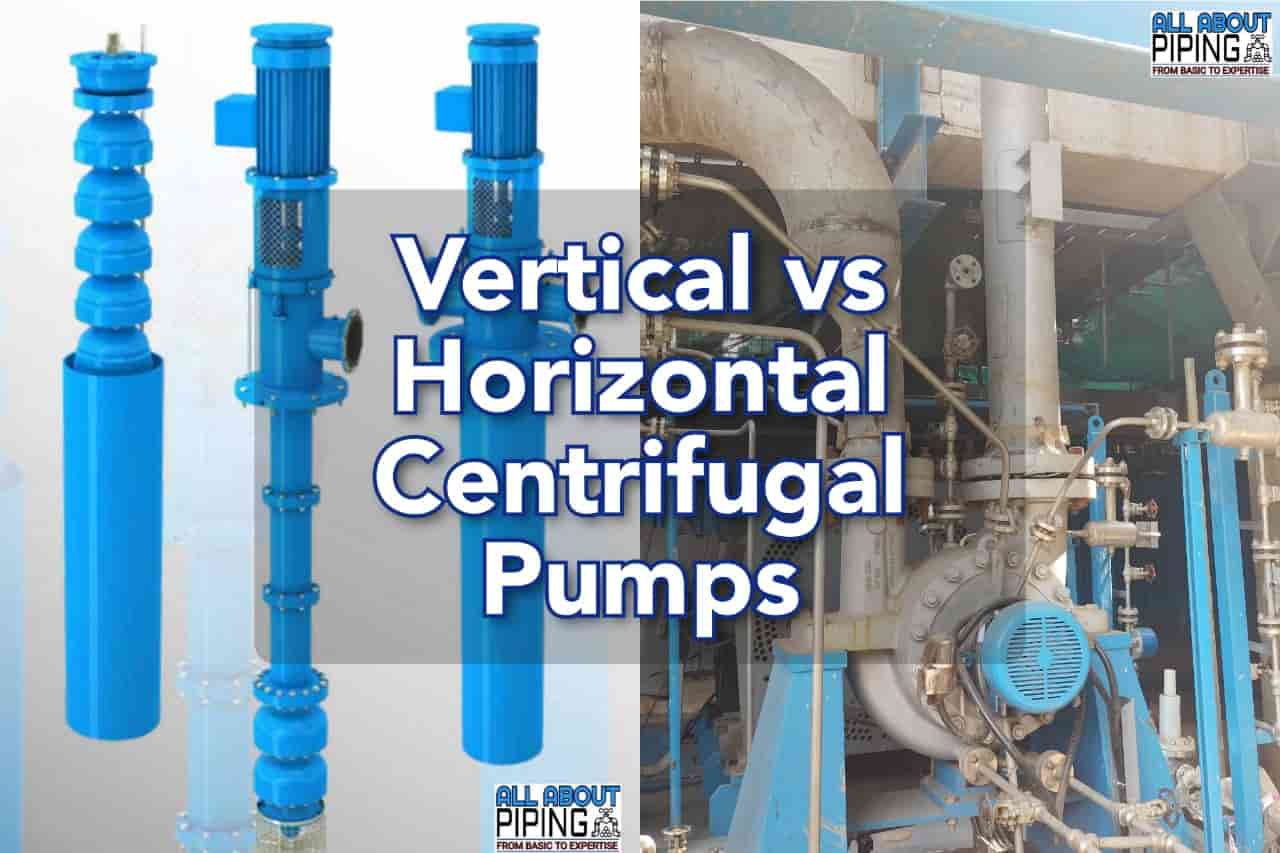In Refineries and Chemical Industries, you must have seen many pumps of different types, sizes, and capacities. The Pumps are of 02 types only which are:
- Dynamic Pumps and
- Positive Displacement pumps
Dynamic Pumps have rotating parts like impellers, whereas Positive displacement pumps have moving parts like pistons. Centrifugal pumps are a type of dynamic pump that is most common in use, simple, tested for its efficiency, cost-effectiveness, and durability. In this article, we will learn about details on types of Centrifugal pumps. i.e. :
- What is a centrifugal pump and how does this work?
- Vertical vs Horizontal centrifugal pump.
- Selection criteria for horizontal or vertical pumps
- Uses of both types of pump.
- Working details of each type of pump
Featured Post: Vacuum Ejector System: Purpose, Selection, Working, Advantages
Table of Contents
What is Centrifugal Pump?

A centrifugal pump is a specially designed mechanical device that propels fluid using the rotational energy of a moving component of a Pump called an impeller. Fluid enters to impeller along its axis and gains kinetic energy and pressure because of the centrifugal force generated by impeller vanes.
The Impeller vane tips are designed in such a way that their action increases fluid velocity and pressure and also directs this toward the pump discharge nozzle. This gained pressure and velocity derives the fluid throughout the system and creates a motive force to reach other equipment connected to the pump.
A centrifugal pump Creates an increase in fluid force by transmitting mechanical power from the electric motor to the liquid throughout the rotating impeller. These pumps are highly cost-effective, easy to install, and efficient for any fluid pumping.
Types of Centrifugal Pump
According to the orientation of the shaft connecting the impeller of the pump to the electric motor there can be 02 types of centrifugal pumps:
- Vertical Centrifugal Pump and
- Horizontal Centrifugal Pump
In the next section of this article, we will learn more details about horizontal pump and vertical pump, their specialty, methods of working, Uses, and Selection Criteria.
More to Read: Piping Supports: Types, Codes, Design, Selection, Working, Installation
Horizontal Centrifugal Pump

This is a type of centrifugal pump where the shaft connected to the electric motor and impeller lays in the horizontal plane. High-speed impeller vanes in the pump drive fluid rotation. And pushes the fluid for transmission.
The multistage horizontal centrifugal pumps are easier to install and maintain. The horizontal position of this type of pump provides easy access to the internal parts. According to the position of the Suction and discharge nozzle, the pump can be of the following type:
- Top Suction Top discharge
- Side Suction Top Discharge
- Side Suction side discharge
Working of Horizontal Centrifugal Pump
A centrifugal Pump is used to develop the pressure and velocity of fluid passing through it. This transmits fluid from low level to high level. Working a horizontal centrifugal pump has a very simple mechanism.
The impeller and casing of the centrifugal pump are the responsible components for the conversion of energy. An impeller is a rotating part while the casing is the stationary part of the pump. In a horizontal centrifugal pump, fluid enters into the casing and falls on the impeller blades, which are whirled tangentially and radially outwards.
The fluid leaves the impeller into the diffuser part of the casing. while passing through the impeller, fluid gains both velocity and pressure for further transmission of fluid from a low point to a high point. In a multistage pump, there is more than one impeller that helps to gain more velocity and pressure.
Uses of Horizontal Centrifugal Pump
A horizontal pump is easy to install, though it takes respectively more space. The uses of Horizontal centrifugal pumps are as follows:
- The fluid system with high temperature.
- A line connected to the spray system
- Used for water circulation
- Used in HVAC for heating, ventilation, and conditioning.
Advantage of Horizontal Centrifugal Pump
- Easy to operate, Dynamically balanced, and No vibration.
- Takes low space for the installation of pipes.
- Create low noise if aligned perfectly under the tolerance limit.
- Easy to maintain and replace the bearing.
- Watertight, there is no air during the transmission of pressure into the fluid.
- Highly efficient and very low failure rate.
- Highly suitable for indoor applications.
Disadvantage of Horizontal Centrifugal Pump
- Installation of the pump needs more space because of the horizontal shaft.
- Working temperature and pressure have lower values compared to the verticle centrifugal pump.
- The limited capacity of providing NPSH (Net pressure suction head)
More Resources: Basics of Project Execution Plan for Piping Planning: A short Briefing
Vertical Centrifugal Pump

Just the opposite, In the case of the Vertical centrifugal pump shaft between the impeller and motor, is installed in vertical condition. This takes much less floor space for installation and is installed just like in a hanging position, because of this a Vertical pump is also referred to as a cantilever pump.
A vertical pump uses a unique shaft and bearing configuration that allows the impeller to hang in the sump while the bearings stay outside. This needs more headroom which makes this more difficult to install and maintain.
Most of the vertical pumps require a pit and barrel. Vertical pumps can only be coupled with electric motors. This type of pump has to face challenges at high suction pressure because of its overhung position.
Working of Vertical Centrifugal Pump
A vertical Pump works typically with a diesel engine or electric motor. These pumps work when fluid passes through the pump through a suction bell. After this fluid moves into the primary stage impeller to raise the velocity of the fluid.
From the impeller, fluid travels through the diffuser bowl over the impeller, where the high kinetic energy of the fluid is converted into high pressure. In the case of a multistage pump, The fluid from the bowl supplies into a secondary impeller which is situated just above the bowl.
Once the fluid supply gets away from the previous diffuser bowl, it flows through a lengthy vertical column toward the outside direction. The rotating shaft within the column is supported at 3 feet intervals with sleeve bushings.
The discharge head of the pump is located at the surface which allows the water flow to modify its direction of flow as per the direction of the discharge pipe.
Use of Vertical Centrifugal pump
- Used for Pipeline pressure booster
- Product transfer and Refinery blending process
- Injection secondary recovery
- Chemical Transfer
- boiler feedwater piping system
- Condensate piping system
- Cryogenic piping
- LNG transfer
- To transfer light hydrocarbons
- To lift seawater
Advantage of vertical centrifugal pump
- The flow rate of the vertical type centrifugal pump is even, stable, and easy to adjust.
- Pumps wearing parts are less.
- Takes less floor space to install.
- Suitable for fluids with high temperature and pressure.
Disadvantage of Vertical Centrifugal Pump
- The performance of the pump is sensitive to changes in the viscosity of a fluid.
- Requires large headroom because of its vertical position.
- For a large multistage pump, this requires a pit and barrel which is costly to construct.
- The overhung design creates a challenge to balance axial thrust at high suction pressure.
- Liquids with dissolved gases are difficult to handle. this can damage the mechanical seal of the pump.
How to Select Horizontal or Vertical Centrifugal Pump?
Selecting a well-suitable pump according to the nature of the fluid, space available, and need is the most essential thing that affects the working efficiency of the pump work. The selection of a Horizontal or Vertical Pump depends on the following factors:
- Space Available: According to floor space availability pump should be selected. A horizontal centrifugal pump needs more floor surface but less headroom while a vertical type centrifugal pump will take less floor surface but more headroom.
- Pressure and Temperature of Fluid: A vertical pump can handle more pressure and temperature of the fluid at its suction nozzle compared to Horizontal pumps.
- Required NPSH (Net Positive Suction head): A horizontal pump can not provide the required value of NPSH than the available. For gaining more than available NPSH we should use a vertical type centrifugal pump.
- Transmission of fluid: Vertical pumps are designed to lift fluid from a high depth area whereas horizontal pumps are not useful for doing so.
Vertical Pump vs Horizontal pump
The major differences between vertical centrifugal pump and horizontal centrifugal pump are as follows:
| SL. NO. | Comparison Factor | Horizontal Centrifugal Pump | Vertical Centrifugal pump |
|---|---|---|---|
| 01 | Position of shaft | Horizontal | Vertical |
| 02 | Space Avalablity | Requires more floor space but less headroom | Requires less floor space but more headroom |
| 03 | Working pressure and Temperature | Can't handle more pressure and temperature of fluid on suction side | Can work efficiently with higher pressure and temperature condition |
| 04 | NPSH | Can not be altered | Can be altered as per requirement |
| 05 | Efficiency | Comparatively high efficient | Comparatively less efficient |
| 06 | Priming | Requires (Except self-priming pumps) | Not required |
| 07 | Maintenance and Installation | Easy | Comparatively tough |
Critical and Non-Critical Pump
The classification of pumps into “critical” and “non-critical” can also apply to different types of pumps, such as horizontal and vertical pumps, depending on their importance to the operation of a facility.
- Critical Horizontal or Vertical Pumps: These are pumps whose failure or malfunction could result in severe consequences for the operation of the facility. Whether they are horizontal or vertical in orientation, critical pumps are essential for maintaining critical processes within the facility. Failure of critical pumps may lead to significant production downtime, safety hazards, environmental damage, or substantial financial losses. These pumps are often involved in handling hazardous fluids, operating at high pressures or temperatures, or serving crucial roles in safety systems. Consequently, critical horizontal or vertical pumps receive special attention in terms of maintenance, redundancy, and reliability to ensure uninterrupted operation and mitigate risks.
- Non-Critical Horizontal or Vertical Pumps: Non-critical pumps, whether horizontal or vertical, are important for the overall operation of the facility but do not pose severe consequences in case of failure compared to critical pumps. While failure of non-critical pumps may lead to reduced production efficiency, temporary shutdowns of specific processes, or minor inconveniences, the impact is generally less severe. These pumps may handle less hazardous fluids, operate at lower pressures or temperatures, or serve auxiliary functions within the facility. As such, non-critical horizontal or vertical pumps may still receive regular maintenance and monitoring, but they typically do not require the same level of redundancy and reliability measures as critical pumps.
In short, whether horizontal or vertical, pumps can be classified as critical or non-critical based on their importance to the overall operation of a facility and the potential consequences of their failure. This classification helps prioritize maintenance efforts, allocate resources effectively, and ensure the reliability and safety of industrial processes.
Conclusion
Centrifugal pump is a type of Dynamic pump that is further divided into 02 types: A) Horizontal centrifugal pump and B) Vertical centrifugal pump. The basic working physics of both types of pumps are very similar, i.e. Application of centrifugal force.
A horizontal centrifugal pump applies centrifugal force by its impeller to generate velocity and pressure of fluid passing through it and transfer it from one equipment to another. While A vertical pump impeller helps fluid to lift from its place and transmit towards another direction.
A horizontal pump will require more floor space while a vertical pump requires less space. There are many advantages and disadvantages of both pumps that help us to lets us choose the most suitable pump for our application.

